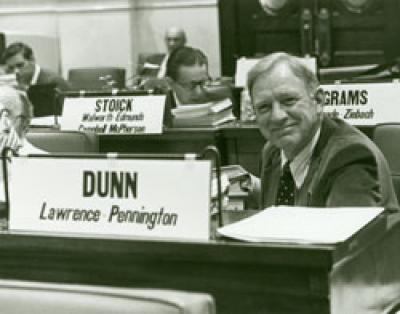James Bernard Dunn
James Bernard Dunn
June 27, 1927
It was the winter of 1946, and a 19-year-old James Dunn found himself at Camp McCoy, an army installation in western Wisconsin. Assigned to Task Force Frost, Jim's job was to test military communication equipment in winter conditions for eventual use in the Korean War. Jim would later recall that more than a few of the items he tested in the freezing Wisconsin weather "weren't worth a damn." It was this frank, down-to-earth attitude that would mark his career, which included a quarter-century at the deepest gold mine in the Western Hemisphere and three decades as a state lawmaker.
Jim Dunn was born in Lead during the summer of 1927. He attended Saint Patrick's School before graduating from Lead High School in 1945. He entered the military in August of that year, just one month before the Japanese signed the document of surrender and put an end to World War II. When Jim was discharged from the Army two years later, he came back to Lead and took up work as a machinist for the Homestake Mining Company. He continued working for the gold mine for more than a decade. During this time, Jim picked up a degree in business administration and economics from Black Hills State College in Spearfish while simultaneously raising four children with his wife Elizabeth.
After receiving his degree in 1962, Jim went on to become the assistant director of public affairs for Homestake. His job duties included representing the mine at regional events, including the South Dakota State Fair. Thanks to his jovial demeanor and passionate way of speaking, he quickly became a well-known advocate of the state and the Black Hills, a reputation that helped him win a seat in the South Dakota House of Representatives in 1971. Two years later Jim was elected to a seat on the South Dakota Senate, a position he occupied until 2000. According to his family, Jim is only the fourth person in state history to have continually held a legislative office for such a length of time.
Jim used his position in the legislature to forward the best interests of the Black Hills, and specifically the Lead-Deadwood area. In 1989 he became the South Dakota Senate's prime sponsor of the bill that would eventually legalize gaming in Deadwood for historic preservation purposes. He also continued to use his position in the Homestake public affairs office to promote the Black Hills, helping to produce magazines, books and motion pictures - including one filmed by PBS and BBC - that focused on the history and scientific advantages of mining in the region. He was promoted to director of public affairs in 1978, and continued to have those responsibilities until his retirement in 1985.
The list of civic organizations to which Jim has contributed over his lifetime is exhaustive, and includes the South Dakota State Historical Society, Lawrence County Historical Society, Lead Civic Association, American Institute of Mining Engineers, Lead Chamber of Commerce, Lead Toastmasters, Black Hills Badlands and Lakes Association, Knights of Columbus and Black Hills Girl Scout Council, over which he presided as its first male president in the 1960s. He continues to be active in the Northern Hills community, volunteering on the boards of the Lead Economic Development Association, Black Hills State University Alumni Association, South Dakota Auto Club and Adams Museum and House.

